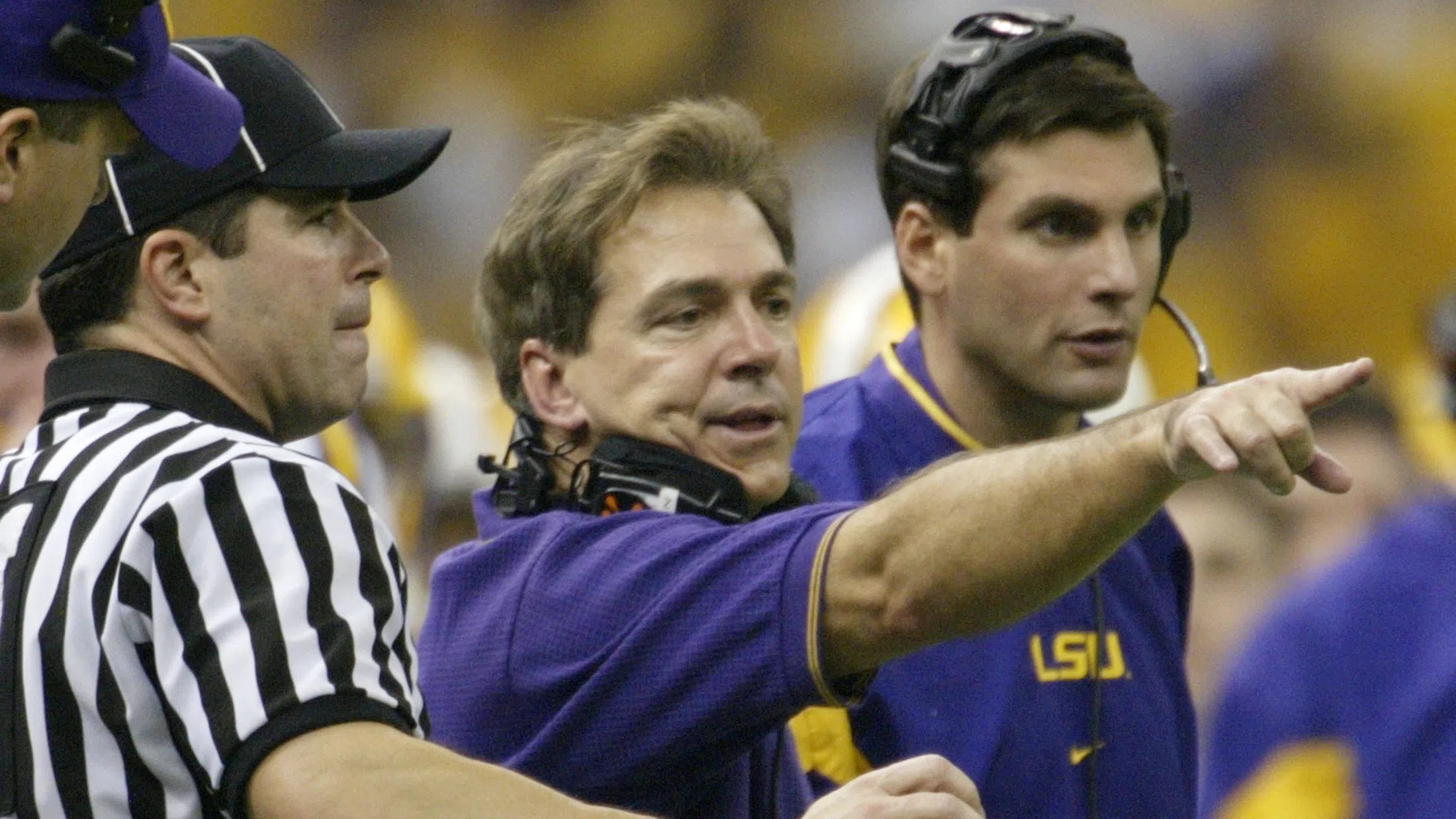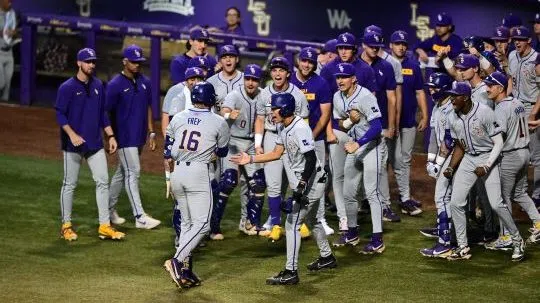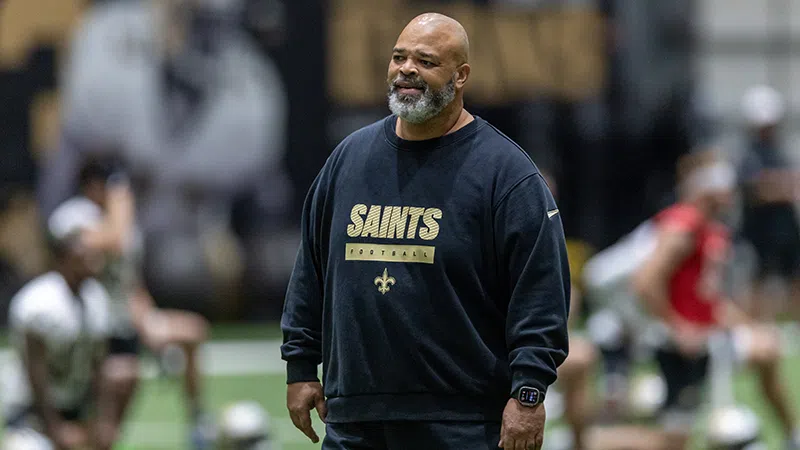
Louisiana State University head coach Nick Saban (C) makes his point to head linesman James Mello in the third quarter of play against the University of Oklahoma in the Nokia Sugar Bowl in New Orleans, January 4, 2004. REUTERS/Pierre DuCharme JLS
By RON HIGGINS
Written for the LSWA
When Nick Saban arrived by private plane in Tuscaloosa in early January 2007 after agreeing to become Alabama’s head football coach, he was mobbed by adoring fans.
But when he appeared in Baton Rouge in late November 1999 at his introductory press conference announcing him as LSU’s coach, the reception was “Who’s Nick Saban and why is LSU paying him $1.2 million a year?”
“I couldn’t believe the response and the attitude people had toward me,” Saban said. “I felt like there were a lot of questions, a lot of doubts. You have to understand. I was coming from a place (Michigan State) where the people were pretty happy over what had been done.
“I was shocked. I was thinking, `Maybe I ought to go back where I came from.’”
Thankfully for LSU, he didn’t, and now he’ll be inducted into the Louisiana Sports Hall of Fame – at last. The Class of 2025 Induction Celebration in Natchitoches is June 26-28, with information available at LaSportsHall.com.
Saban was initially elected to the LSHOF’s Class of 2020, but that spring’s global pandemic postponed ceremonies. It also altered the NCAA football recruiting calendar, which prevented then-Alabama head coach Saban from being inducted until after his retirement in January 2024.
“It’s an honor I’m really excited about,” Saban said of his upcoming induction. “I never thought I’d be considered. I know there’s a lot of great sports folks in Louisiana.”
All Saban did in five seasons from 2000-04 was save the Tigers’ program with a national championship, two SEC titles, and a 48-16 record (.750) before chasing an NFL dream as the head coach of the Miami Dolphins.
He came to Baton Rouge at a time when LSU was thirsting for success, stability, and a coach with a vision, including the elements required to build and sustain a national power.
After LSU had just two head football coaches (Paul Dietzel and Charles McClendon) in 25 years from 1955-1979, the Tigers had six coaches in 20 seasons from 1980-1999.
In that period, LSU won SEC championships in 1986 and 1988, but after the ’88 title, the Tigers had eight losing seasons in 11 years.
When LSU fired Gerry DiNardo with one game left in 1999, it already had a list of coaching candidates it wanted to pursue.
But Saban wasn’t originally on it.
He was a Bill Belichick disciple who worked as Belichick’s defensive coordinator for four seasons with the Cleveland Browns. Then, he was a college head coach for six seasons, including five at Michigan State, where he was basically a .500 coach in his first four seasons with the Spartans before posting a 9-2 record in 1999.
When DiNardo was let go at LSU, Saban didn’t know about the situation until he did some research.
“One of the other things that piqued my interest was that when I was in the NFL, somebody did a study, probably Belichick because he was notorious for this kind of detail,” Saban said. “The study revealed per capita which state had the most players from its colleges playing in the NFL. Louisiana was always ranked third or fourth. I always remembered that.”
Saban’s contact with LSU came through his Memphis-based agent Jimmy Sexton. Sexton gauged Saban’s interest, and then had his business partner Sean Tuohy contact then-LSU athletic director Joe Dean because of Tuohy’s long-standing friendship with Dean.
From that point, steps toward the Saban-LSU marriage were over-the-top clandestine. He agreed to meet with LSU officials at Sexton’s house in Memphis.
“I was getting beat up so bad at Michigan State (by the media) because word was out I might leave,” Saban said. “I felt if I went to Baton Rouge for an interview, I’d have to take the job, and I didn’t know enough about it to know if that was what I really wanted to do.”
So, Saban dispatched his wife Terry “on a secret mission” to get a personal look at his potential next coaching stop. It’s something he hadn’t done before and hasn’t done since.
She knew she had successfully stayed under a cloak of secrecy when she ate lunch with Emmert’s wife at TJ Ribs. The popular Baton Rouge restaurant had a blackboard on which patrons could vote for who they thought the next LSU coach would be.
Nick Saban’s name wasn’t on the board, so Terry Saban asked the waiter to add the name of “Nick Saban.”
The waiter had no clue who Nick Saban was.
Meanwhile, Terry’s husband was dazzling Emmert and the other LSU officials.
“We liked his attitude toward the student-athlete and his analytical approach to building a program,” Emmert said. “We all came away feeling this was somebody who could do what we wanted.”
Terry Saban did her due diligence, returned home, and gave her husband an honest review of the strengths and weaknesses of the LSU situation.
“She went in the weight room and there were a bunch of players working out,” Saban said. “She said they had some `damned good-looking players.’”
Sold!
For $1.2 million annually, the most ever paid to an LSU coach in any sport at the time, Saban agreed to become the 31st head football coach in LSU history.
It wasn’t long in Baton Rouge and especially at LSU that Saban became a force of nature.
For instance, LSU had one of the worst graduation rates in the SEC when he arrived, so his priority was obtaining a new academic center for athletes. He was told it would take two to three years for LSU to procure the money from the state legislature for such a project.”
“I told (then-new LSU athletic director) Skip (Bertman) `Let’s go raise the money,”’ Saban recalled. “Then, we were told `You’ve only got to raise $8 million for the academic center, but we want to redo this other thing here and make a big auditorium because we don’t have a big auditorium at the university, and that’s going to cost another $7 million.’
“I told Skip, `Let’s just raise $15 million and build the damn thing.’ And we raised it about three months. I kind of tricked them, though. I gave about $50,000 to start it off, so everybody I asked almost had to do that.”
Saban also noticed there wasn’t much revenue available for capital improvements. He suggested LSU finally start seat licensing, but met stern resistance.
“I was told we had loyal fans that had the same seats for years and years,” Saban said. I said, `Look, a lot of schools have done this.’ They said, `If you don’t win, we’ll get crucified for doing that.’ I said, `Put it on me then because if we don’t do it, we’re never going to have the kind of program we’re going to need to compete with all these other people.’”
Saban immediately upheld his end of the bargain.
He changed the program’s culture through “The Process,” his revamped coaching philosophy born Nov. 7, 1998, when Saban’s 30-point underdog Spartans scored 19 straight second-half points for a 28-24 win at No. 1-ranked and unbeaten Ohio State.
“That’s when I started,” Saban said, “the whole process-oriented `one play at a time, play the next play, don’t worry about what happened on the last play.’ I felt that was the only way we would have a chance in that game. The players actually did it. They played loose, free, they weren’t worried about winning. They just focused on what was in front of them.
“That told me `This is a much better way to do it than talking about winning.’ Play the next play, dominate your box every play, just focus on that and not the outcome.”
Saban educated the Tigers, but also learned a few things exclusive to college football in the South.
For instance, he didn’t understand why Louisiana state police troopers escorted him to midfield for a postgame handshake with the opposing coach and then flanked him as he left the field.
“I’d never had cops before,” Saban said.
Of course, he didn’t.
Saban had never coached below the Mason-Dixon line, where Alabama legend Bear Bryant began the time-honored Southern tradition of state trooper escorts in the late 1950s.
“I said, `Why do I need you guys?’” Saban said.
Then in the fifth game of his first LSU season, with the Tigers off to a 2-2 start and reeling from two straight losses, including a home stunner to UAB, LSU faced No. 11 Tennessee.
As it played out, the Tigers won a 38-31 overtime thriller in Tiger Stadium. When LSU’s Damien James knocked down one last Tennessee fourth-down pass, most of the stadium emptied onto the field to tear down the goalposts. Saban found Tennessee coach Phillip Fulmer for a handshake and looked for an escape route through an ocean of fans back to the Tigers’ dressing room in the north end zone.
“When that happened,” Saban recalled, “I said `Now I know why I have these cops.’ I could have gotten killed without them.”
There would be many more times that Saban’s troopers, led by Mike Edmundson, would clear a path after big wins.
Saban never won fewer than eight games in all of his LSU seasons. He had three bowl wins, including the BCS national title game victory in the Sugar Bowl over Oklahoma. His SEC championship game victories came against Tennessee and Georgia.
The win against the Vols in the 2001 league title lit the fuse for LSU’s national championship run two years later.
LSU had lost at Tennessee 26-18 earlier in the ’01 regular season. When the teams met again in December in the Georgia Dome, the No. 2-ranked Vols were a win away from advancing to the Rose Bowl and playing for the national championship.
Yet despite the Tigers losing starting quarterback Rohan Davey and leading rusher LaBrandon Toefield with first-half injuries, LSU roared back from a 17-7 deficit to score a 31-20 upset.
After a pair of superb recruiting classes two seasons later, Saban’s 13-1 Tigers delivered the school’s first national championship since 1958 by beating Oklahoma 21-14.
“When we played Oklahoma in the championship game, they had some incredible stats,” Saban recalled. “They were scoring like 50 points per game, it was unbelievable. I’m saying, `How in the hell are we ever going to beat these guys?’
“We just got the players ready to play. I remember I told the players, `Let’s not think about winning the national championship. Let’s go to work and prepare for this game as if you’re going to play against the best player you’ve ever played against and try to play the best we can play to give us an opportunity to win the game.’
“The 2003 team had so much character that it didn’t need a leader. They thought they would win the championship long before I did.”
As a result of winning the national title, Saban landed the nation’s No. 1 recruiting class. It was a group that would help Les Miles, the next LSU coach, win a national championship in 2007.
At the end of the 2004 season, a $5 million per year contract and assured he’d have control of player personnel decisions, Saban became head coach of the Miami Dolphins.
“I had in the back of my mind that the ultimate success was to be a head coach in college and win a national championship, go to the NFL and have a successful program there,” Saban said. “But I hadn’t planned to leave LSU. I told (Dolphins owner) Wayne Huizenga `no’ five times. He came to my house on Christmas Eve and talked me into it.”
When Saban returned to the NFL for the first time in 10 years, it was vastly different than when he last coached in the pros as the Cleveland Browns’ defensive coordinator in 1994.
Back then, the NFL had just introduced free agency in 1993, so Saban, a man who likes control of his roster, hadn’t fully experienced the rapidly growing roster instability and volatility of players having the freedom to jump ship.
“It was a completely different dynamic,” Saban said. “I’m not saying it in a bad way, but it was different. I knew when I took that job and was there for a while that my legacy really should be as a college coach.”
So Saban, who had a 15-17 record in two seasons with the Dolphins, began looking at college vacancies.
“The best job that was available was Alabama, which happened to be a rival to the place (LSU) in which I had a tremendous amount of pride in terms of what we were able to accomplish, what we were able to do and a lot of the relationships we made,” Saban said.
Because of that, Saban became public enemy No. 1 to a segment of LSU fans who forgot how he rescued the Tigers’ program from the garbage heap.
It didn’t help Saban’s relationship with the Tigers’ faithful that he won six national titles with the Crimson Tide in 17 seasons and had a 13-5 record vs. LSU. That included an eight-game win streak that started with the Tide blanking the Tigers 21-0 for the 2011 national title in the BCS championship game in New Orleans and ending with a 46-41 loss in Tuscaloosa to LSU’s eventual 2019 national champions.
Upon his retirement, he joined ESPN’s College GameDay before the start of the 2024 season. He’s also had time to reflect on his career move from LSU with a tinge of regret.
“You live and learn, do things, and you find out about yourself,” Saban said. “LSU has a great atmosphere, the people are so supportive, and I have a tremendous amount of respect for that program. It’s one of the greatest places athletically in the country right now.
“Terry and I still have as many good relationships in Louisiana as any place in the world, great friends and good people. We cherish those relationships.”
It’s why Saban is genuinely touched to become the fourth LSU head football coach in the LSHOF, joining Dietzel, McClendon, Miles and Bernie Moore. Jerry Stovall, LSU’s coach from 1980 to 1984, was elected in 1981 for his standout Tigers’ playing career.
“I’m very grateful to many people who contributed to the success we had when we were at LSU,” Saban said. “We had a lot of really good players and people.”
Ron Higgins, the first Louisiana native to serve as president of the Football Writers Association of America, was enshrined last year in the Louisiana Sports Hall of Fame. He writes for ShreveportBossierJournal.com.
For updates on the 2025 Induction Celebration, use this link:
lasportshall.com/InductionInfo
or text “InductionInfo” to 41444
@LaSportsHall on X (formerly Twitter)
Instagram: lasportshall
Facebook.com/LASHOF
LaSportsHall.com

More Top Stories










